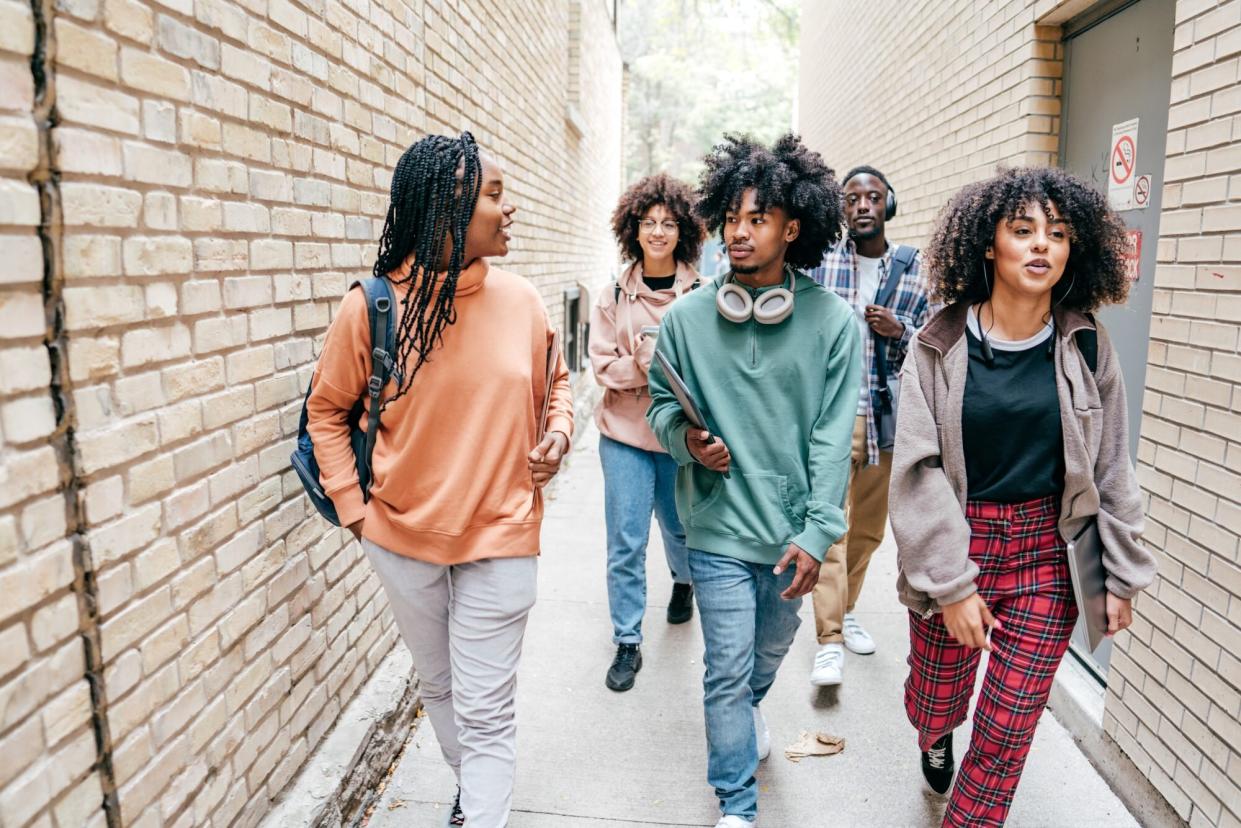Why Black Teens Need to Have Black Friends at School

- Oops!Something went wrong.Please try again later.
Getty Images
Ava says she has a lot of Black friends at her Chicago high school. She attends Kenwood Academy High School a predominantly Black school with a Black student population of roughly 86%.
A multidisciplinary team at Cornell University found that friends of the same ethnic or racial background are key to teens' sense of inclusion within their school environment. In a study of 4,500 students that spanned three semesters, the team found that while friends of different ethnic backgrounds can influence each other and share close connections, friends of the same racial background have an influence that's far greater.
"It's a time in young people's development when peers' influence grows relative to that of parents," Adam Hoffman said in an interview with Phys Org. Hoffman is an assistant professor of psychology and human ecology at the university and an expert in the fields. "And teens with similar social identities and backgrounds are likely to share common experiences that could facilitate belonging," he said.
Ava finds herself to be inspired by her Black friends. "It's like, okay, yeah, you're my friend, and we can discuss this. I know you," she says. "We get along. I know that I can trust you, whatever I need."
Overall, Ava loves the vibe of the predominantly Black Kenwood environment, where she feels both welcomed and safe. She also thinks that the school does have its own version of diversity.
"I get different experiences from each person that I meet," Ava says. "Like, you can't really say every Black person is the same and every experience is definitely different depending on where you grew up." Ava's friends come from various neighborhoods in the city of Chicago. This may not sound like much on the surface, but Chicago is one of the most segregated cities in the US.
Ava's mom, Chicago Glitter and Confettees owner Eve Gyneth, offered a different perspective on her daughter's attendance at Kenwood.
"I wanted her to go to a predominantly white school like Jones [Academy], mainly for the academics, and also because she'd be a third-generation alumni," says Gyneth. "To me, it wasn't actually very important. Many of my friends in high school were Latino." Gyneth does appreciate the diversity of the neighborhood that Kenwood resides in: Hyde Park.
Retired Chicago Public Schools teacher Diane Robinson worked with students for over 30 years, in all corners of the city and in all different neighborhoods. From predominantly white schools to primarily Black schools, to predominantly Latino schools, to those with a more mixed student body, she's run the gambit of educational environments.
"[Schools] should have a diverse population. It should be a mix," says Robinson. "But it's hard to do that in public schools. It really is hard to do that in private schools. Magnet schools seem to be a bit easier in keeping balance with diversity."
When it comes to building a diverse student body, location, accessibility, and grade of education are obviously influential factors. Predominantly Black schools that lack these elements are often neglected because of issues like racism and lack of funding. Schools in Black and brown neighborhoods receive significantly less funding compared to schools in white neighborhoods.
Robinson also says it is important to have positive Black role models within a school, regardless of the diversity of the Black student population. She says they can help assuage a situation where there's a lack of Black friendship.
"If you have a good Black mentor, it can offer a sense of self, of culture. A good mentor, or teacher, can help students navigate through that," she says.
Robinson stresses the importance of diversity. "I think (diverse populations) can affect Black students in a positive way. Different backgrounds, different races, different cultures. Sometimes they can make lifelong friends," Robison says. "But they still need to keep this sense of who they are, not to abandon their Blackness or Black heritage. Embrace other ethnicities, but remain true to themselves."
Living in Empathy licensed therapist Erin Matthews, LCSW talks about identity and friendship often with her 14-year-old daughter. "We have these conversations all the time. And there's something different about having a friend who you don't have to explain to about race and culture and all the things that they see on social media, and how it fits differently when you're Black," says Matthews.
Matthews's teen now goes to a diverse school but didn't from kindergarten through seventh grade. "That's been a major shift, going from Chicago to the suburbs of Atlanta."
The research team of the study defines school belonging as, "how accepted, respected and supported students feel in their classrooms, cafeterias, and clubs." But for Matthews, belonging among Black peers is more along the lines of speaking a similar language, and sharing unique experiences.
"Belonging was more of that chain banter and being able to make jokes, understanding the nuance of Black culture, understanding what they see on social media," says Matthews. "It's a different lens that they see through. That sense of feeling strong and bold and proud of being Black."
"And especially, it's so important to find an outlet for them where they can be with other kids just like them, going to predominantly white schools," she says. Matthews suggests that Black parents of teens in cross-ethnic schools that aren't majority Black reach out to other parents in similar situations in countywide or city-wide programs like Jack and Jill. She says solidarity in circumstance can bring kinship and friendship.
"Constantly having to explain, constantly having to go within themselves in environments where they can't be fully free—that's what leads to anxiety and depression," says Matthews. "And we're seeing more and more Black teens, and college-aged kids, really struggling, and the suicide rate becoming more glaring in our face. That community piece cannot go away. It has to increase."

